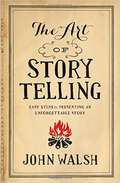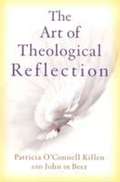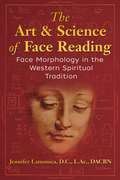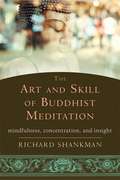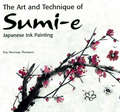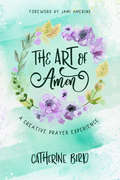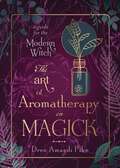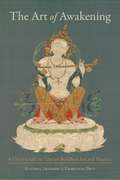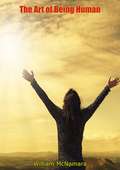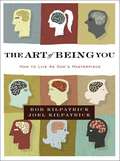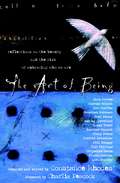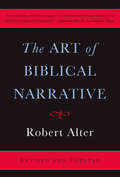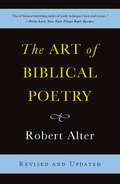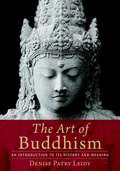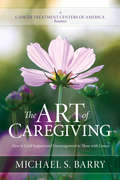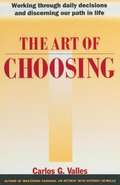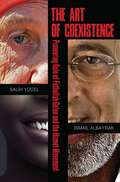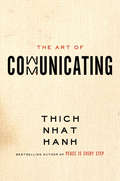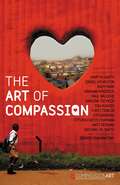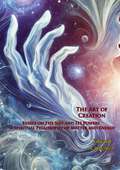- Table View
- List View
The Art Of Storytelling: Easy Steps To Presenting An Unforgettable Story
by John D. WalshMany of us would love to hold the attention of a crowd, a classroom, or just a group of our friends by telling them a great story. We have felt the pressure of a public presentation or the disappointment of telling a story that others ignore. We are ready to be heard, ready to captivate. In The Art of Storytelling, John Walsh takes us through the steps to presenting a compelling story—outlining the strategies that helped him move from stutterer to storyteller. This book will help any person with a story to share by walking you through all aspects of presentation . . . from what to do with your hands as you speak all the way to crafting a killer ending. Whether you’re telling bedtime stories to your children or Bible stories to a congregation, this book will take your storytelling to a new level.
The Art Of Theological Reflection
by John De Beer Patricia O'Connell KillenHere is a book for the millions of Christians who want to make a vital connection between their faith and their lives. The authors describe theological reflection as "the artful discipline of putting our experience into conversation with the heritage of the Christian tradition. " Their practical book provides a way for all of us to experience greater meaning in life and a more tangible sense of God's creative presence.
The Art and Architecture of Islam, 1250-1800
by Sheila S. Blair Jonathan M. BloomThe authors present a provocative essay on the varied legacies of Islamic art in Europe and the Islamic lands in the nineteenth and twentieth centuries.
The Art and Science of Face Reading: Face Morphology in the Western Spiritual Tradition
by Jennifer LamonicaA complete, illustrated guide to the ancient tradition of reading the face to gain insight into health, personality, relationships, and career • Details how to read the profile, front face, features, and musculature of the face to reveal temperament, personality traits, health predispositions, and mental state • Explores the history and development of face morphology from its origins in Israel and Egypt more than 4,500 years ago to its modern use in French medical schools • Examines the Foursquare diagram, developed by French occultist Papus, for highly accurate and detailed facial readings The face is a unique reflection of our genetic, inherited inclinations as well as the effects that life, nature, and relationships have had upon us. By looking at a person’s face, you can gain valuable insight into their personality, health, and how they navigate in the world. In this illustrated guide, Jennifer Lamonica reveals the sacred tradition of face morphology, an esoteric system that has been passed quietly from rabbi to student as an unbroken oral tradition for more than 4,500 years. She explores the history and development of this ancient art from its origins in Israel and Egypt to its use as the major diagnostic system in Europe until the Enlightenment and its current applications in French medical schools. Sharing the techniques of master face readers, the author details how to read the angles of the profile, as well as palm color and nose shape, to determine a person’s temperament, providing health and career insight into each of the four temperaments, including nutritional needs, digestive issues, sleep patterns, health predispositions, and ideal occupational paths. Exploring the Foursquare diagram, developed by French occultist Papus, for highly accurate and detailed facial readings, she explains how to read the front face in combination with planetary shapes, which reveal a person’s character; the major facial features, such as eyebrows, which reveal personal inclinations; and the musculature of the face, including expressions, which reveals a person’s current mental state. Providing case studies, she examines how to apply face morphology in relationships and in parenting. Exploring the meaning of each facial variation, while also honoring the intuitive impression received at first glance, Lamonica reveals how the ancient science of face reading allows you to compassionately help your loved ones, students, or clients, as well as overcome personal obstacles and better know yourself.
The Art and Skill of Buddhist Meditation: Mindfulness, Concentration, and Insight
by Richard ShankmanFor the first time ever, a leading Insight meditation teacher presents an innovative and practical guide to building a strong meditation practice by unifying both concentration and insight meditation. In our busy modern world, it's easy to get stressed out. In The Art and Skill of Buddhist Meditation, mindfulness teacher Richard Shankman offers a foundational guide to the art and skill of Buddhist meditation, showing you how to construct a calming daily practice that unifies two major Vipassana Buddhist traditions--concentration meditation and insight meditation. Whether you are a beginning or intermediate student of Buddhism, this book provides a user-friendly meditation regime. New readers are presented with a strong foundation in multiple meditation approaches, while those who've been training for a while will be able to better integrate what they've already learned with new and unfamiliar approaches drawn from other streams of Buddhist thought. This new, integrative, and simple approach to meditation will help you to better manage stress, quiet your busy mind, and cultivate a lasting sense of well-being.
The Art and Technique of Sumi-e Japanese Ink Painting
by Kay Morrissey ThompsonThe art of sumi-e, which literally means "ink picture," combines calligraphy and ink-painting to produce compositions of rare beauty. This beauty is paradoxical-ancient but modern, simple but complex, bold but subdued-no doubt reflecting the arts spiritual basis in Zen Buddhism. At the same time sumi-e is firmly rooted in the natural world, its various techniques serving as the painter's language for describing the wonders of nature.Art and Technique of Sumi-e Japanese Ink-Painting explores this ancient technique. Buddhist priests brought the ink stick and the bamboo-handled brush to Japan from China in the sixth century, and over the past fourteen centuries Japan has developed a rich heritage of ink-painting. Today the artistry of sumi-e can be admired in books, reproductions and museums, but the techniques of the art have been much less accessible. As a result, little information has been available to the inquisitive Western artist attracted to ink-painting. This book, designed to help remedy that deficiency, is the product of the author's study with her teacher, Ukai Uchiyama, master calligraphist and artist.
The Art of Amen: A Creative Prayer Experience
by Catherine BirdLet creativity bring your prayers to life.Too often, prayer time is pushed to the bottom of a never-ending to-do list and can start to feel like a chore. But when God gave us the gift of prayer, he was inviting us to set aside regular, consistent time to grow in our relationship with him. Infused with biblical truths, The Art of Amen will rejuvenate you with an artful blend of teachings on prayer and rich examples of creative prayer styles—such as Bible journaling, prayer walks, and intercessional prayer art.The Art of Amen will help you grow in your practice of prayer and explore the reasons why you pray. You’ll also take a fresh look at what Jesus says about prayer and what it means to invite the Holy Spirit into your life. Whether for personal worship or small group study, this creative prayer experience takes the guesswork out of prayer and is the perfect tool to help you build a deeper relationship with God.
The Art of Aromatherapy in Magick: A Guide for the Modern Witch
by Dree Amandi PikeInfuse Your Magickal Practice with the Natural Alchemy of PlantsA practical guide to the magick of essential oils, this book merges scent with spell, teaching you how to incorporate potent botanical power into your unique practice. Dree Amandi Pike, a professional aromatherapist and spiritual counselor, explores what essential oils are, where to get them, and how to select the right ones for any application—mystical or mundane.With fifty-five informative essential oil profiles, this book encourages you to venture beyond lavender's familiar fragrance to create bespoke oil blends for health, spellcraft, meditation, and more. Improve your witchcraft with dozens of exercises and recipes, including Body Worship Lotion, Blessed Bubbles, Lucky Roller Perfume, and a Terracotta Protection Talisman. With this book’s safe, eco-friendly, and ethical techniques, you can skillfully harness aromatic tools to elevate your magical prowess and nurture your spiritual well-being.
The Art of Awakening: A User's Guide to Tibetan Buddhist Art and Practice
by Charlotte Davis Konchog LhadrepaA presentation on the Tibetan Buddhist path to enlightenment, through the lens of an artist's eye and experience.The sacred arts play an essential, intrinsic role in Tibetan Buddhist practice. Here, one of the great practitioners and master artists of our time presents a guide to the Tibetan Buddhist path, from preliminary practices through enlightenment, from the artist's perspective. With profound wisdom, he shows how visual representations of the sacred in paintings, sculptures, mandalas, and stupas can be an essential support to practice throughout the path. This work, based on the author's landmark Tibetan text, The Path to Liberation, includes basic Buddhist teachings and practices, clearly pointing out the relevance of these for both the sacred artist and the practitioner, along with an overview of the history and iconography of Buddhist art.
The Art of Being Human
by William McNamaraIn THE ART OF BEING HUMAN, Father McNamara has taken a new, vital approach to effective socially oriented Christian living in tune with the needs and demands of our times. He takes for his theme the basic traditional truth: grace builds upon rather than destroys human nature, and develops this theme with extraordinary understanding and eloquence.The first chapter—“Becoming Human”—sets the tone of the book. For Father McNamara the sanctifying process is the humanizing process and the way by which one can cultivate “the art of being human” within oneself. He then probes into the very roots of the conditioning processes which daily shape our lives, and poses for the reader some incisive questions which demand reflection and inner search. Discussions on faith, hope, love, religion, mental prayer, and spiritual growth follow. The final chapters on leisure and leadership are especially provocative since they direct the reader’s attention to where the responsibility for the self-accomplishment of this “art” truly lies.Father McNamara has the knack of putting his finger directly on the problems of today’s living. THE ART OF BEING HUMAN does not pretend to have all the answers but it goes a long way toward taking the reader in the right direction.
The Art of Being You: How to Live as God's Masterpiece
by Joel Kilpatrick Bob KilpatrickI heard a well-known Christian musician say at a concert that God was in the business of fixing broken people. I went home and thought about that for a while, and I came to a different conclusion... That different conclusion, reached by singer/songwriter Bob Kilpatrick, has some interesting and exciting applications for re-thinking what it means to be a Christian. Rather than casting God in the usual role as architect and great mechanic of the universe, Kilpatrick instead paints a portrait of God as an artist—passionate, visionary—who considers humankind his masterpiece. God doesn't see Christians as broken beings chugging along in a fixed-up life. He sees us as new creations, whole, complete, and a stunning part of his creative process. It's a powerful perception of God, one that determines how much we understand and enjoy God, which, in turn, affects the entire course of our lives. We'll stop perceiving God based on what we lack, what we need repaired, and how weak we are, and come to know God as a creator who sees each one of us as a work of beauty and value. If we believe our relationship with God is one of artist/masterpiece/creative process, then we have every reason to rejoice in every stage of that process. The Art of Being You offers every reason to believe that God is preparing us for an amazing heavenly display.
The Art of Being: Reflections on the Beauty and the Risk of Embracing Who We Are
by Constance Rhodes Charlie Peacock“There’s an art to being anxious for nothing. There’s an art to being at peace with God, your neighbor, your world, and yourself. Oh what a great friend, follower, and citizen you are if you are at peace just being you. Start there, and you can go anywhere. ” –from the foreword by Charlie Peacock It’s Not What You Do. It’sWho You Are. In today’s achievement-oriented culture, it can feel impossible to separate who we are from what we accomplish. We introduce ourselves by announcing what wedofor a living. Endless “to do” lists drive us away from self-discovery and true contentment. We hope that our successes will cause our busyness to feel worthwhile, yet despite our accomplishments, we long for something more. Featuring original essays and stories from a diverse list of contributors including Jonathan Foreman (Switchfoot), Sara Groves, Matthew Odmark (Jars of Clay), Gloria Gaither, Don and Lori Chaffer (Waterdeep), Tammy Trent, and Linford Detweiler (Over the Rhine),The Art of Beingexplores what it really means to “be” who we are. Here you will find an encouraging, challenging companion on your journey toward discovering your true identity–and toward finding a satisfaction that lasts. Life Is Not a Resumé Higher bank balances, stylish clothes, and popularity among our peers may look impressive on the surface, but these things don’t satisfy our craving for contentment. True satisfaction is found when our spirit is fed with a sense of purpose. The stories and reflections inThe Art of Beingwill inspire you to resist the disappointing pursuit of the temporal and explore a deeper understanding of who you are as the unique artwork of your Creator.
The Art of Bible Translation
by Robert AlterAn award-winning biblical translator reflects on the art of capturing the literary power of the Bible in EnglishIn this brief book, award-winning biblical translator and acclaimed literary critic Robert Alter offers a personal and passionate account of what he learned about the art of Bible translation over the two decades he spent completing his own English version of the Hebrew Bible.Alter’s literary training gave him the advantage of seeing that a translation of the Bible can convey the text’s meaning only by trying to capture the powerful and subtle literary style of the biblical Hebrew, something the modern English versions don’t do justice to. The Bible’s style, Alter writes, “is not some sort of aesthetic embellishment of the ‘message’ of Scripture but the vital medium through which the biblical vision of God, human nature, history, politics, society, and moral value is conveyed.” And, as the translators of the King James Version knew, the authority of the Bible is inseparable from its literary authority.For these reasons, the Bible can be brought to life in English only by re-creating its literary virtuosity, and Alter discusses the principal aspects of style in the Hebrew Bible that any translator should try to reproduce: word choice, syntax, word play and sound play, rhythm, and dialogue. In the process, he provides an illuminating and accessible introduction to biblical style that also offers insights about the art of translation far beyond the Bible.
The Art of Biblical Narrative
by Robert AlterSince it was first published nearly three decades ago,The Art of Biblical Narrativehas radically expanded the horizons of biblical scholarship by recasting the Bible as a work of literary art deserving studied criticism. Renowned critic and translator Robert Alter presents the Hebrew Bible as a cohesive literary work, one whose many authors used innovative devices such as parallelism, contrastive dialogue, and narrative tempo to tell one of the most revolutionary stories of human history: the revelation of a single god.
The Art of Biblical Poetry
by Robert AlterThree decades ago, renowned literary expert Robert Alter radically expanded the horizons of biblical scholarship by recasting the Bible as not only a human creation but a work of literary art deserving studied criticism. InThe Art of Biblical Poetry, his companion to the seminalThe Art of Biblical Narrative, Alter takes his analysis beyond narrative craft to investigate the use of Hebrew poetry in the Bible. Updated with a new preface, myriad revisions, and passages from Alter’s own critically acclaimed biblical translations,The Art of Biblical Poetryis an indispensable tool for understanding the Bible and its poetry.
The Art of Buddhism: An Introduction to Its History and Meaning
by Denise Patry LeidyAs its teachings spread from the Indian subcontinent in all directions across Asia, Buddhism influenced every culture it touched--from Afghanistan to Korea, from Mongolia to Java. Buddhist art is a radiant reflection of the encounter of the Buddha's teachings with the diverse civilizations that came under their sway. It is also an intriguing visual record of the evolution of Buddhist practice and philosophy over a period of more than two millennia. Denise Leidy's guide is the perfect introductory text for all those intrigued by this splendid aesthetic tradition. It also an essential resource for all who seek to understand Buddhist art as teaching.
The Art of Budo: The Calligraphy and Paintings of the Martial Arts Masters
by John StevensExplore this stunning collection of spiritual calligraphy by Japan&’s greatest martial arts masters—with commentary from Zen art authority and aikido master John Stevens.Beginning with the legendary samurai Miyamoto Musashi, nearly all of the great martial arts masters left a legacy of calligraphy and painting. Their artwork—Zenga and Zensho (&“Zen pictures&” and &“Zen calligraphy&”)—was not only an extension of their Zen practice but also reflected their deep spiritual commitment to the budo ethos, the perfection of self through martial arts training. This book presents a concise history of this tradition, with works from such samurai as Musashi, Takuan, Yagyu, Motusgai, Rengetsu, Tesshu Deishu, Kano, Morihei, and others. Aikido master John Stevens is an expert on Zen and budo art, and he provides a fascinating introduction to the tradition and biographical details on each of the warrior artists, and brief, illuminating commentary on each piece.
The Art of Caregiving
by Michael S. BarryWritten to encourage the caregiver, The Art of Caregiving will be a candle of joyful hope to the one whose life has taken on unique new challenges when a loved one faces cancer.Cancer treatment is often a nighttime journey through a wilderness, during which patients and their caregivers are confronted with worry and fear; a journey where the slightest flicker of hope means more than words can express.Michael S. Barry shows how, with God's help, you can be the light of hope for those who bear the burden of illness.
The Art of Channeling: Modern Methods for True Telepathic & Spirit Communication
by Jenny TysonInnovative Mediumship Techniques Everyone Can UseIntroducing a new method of channeling, this hands-on book shows you how to receive messages from any kind of spirit. Medium Jenny Tyson shares easy and accurate ways to communicate with spirits of the dead, angels, ghosts, nature and animal spirits, extraterrestrials, and even the universal mind that is the source of all knowledge.From esoteric rituals to paranormal investigations, this beginner-friendly book can be used in a variety of settings and provides much higher accuracy than traditional channeling methods. Jenny teaches you how to choose the best spirit type for your situation, format your questions to remove biases, and conduct a successful session. You'll explore fascinating case studies, spirit board and dowsing techniques, group practice, trance channeling, and more. Also suitable as a companion to The Art of Scrying & Dowsing, this book gives you access to the secrets of the universe.
The Art of Choosing
by Carlos G. VallesUsing insights from scripture, Ignatian spirituality, and contemporary examples, Valles illustrates the basics of making choices with care and forethought.
The Art of Coexistence: Pioneering Role of Fethullah Gulen and the Hizmet Movement
by Ismail Albayrak Salih YucelThe global threat of war, terrorism, the increased gap between poor and rich, famine, malnutrition, global warming and pollution, and many other social and cultural problems, pose a real challenge for present citizens of the globe. Intellectuals and politicians take these challenges as their primary concerns. Despite the existence of some pessimists, there are a number of initiatives working for the common good and expending great effort to solve these problems. The Hizmet (Gulen) Movement is one of the most influential initiatives that should be taken into consideration in this context. Fethullah Gulen is a Turkish Muslim scholar whose ideas have inspired and influenced many Turkish intellectuals, educators, students, businessmen, politicians and journalists inside and outside Turkey to establish schools, educational and intercultural centers, and humanitarian aid organizations in more than one hundred fifty countries. Yucel and Albayrak cover the Hizmet Movement under the leadership of Fethullah Gulen from various perspectives in order to shed lights on current discussions.
The Art of Communicating
by Thich Nhat HanhZen master Thick Nhat Hanh, bestselling author of Peace is Every Step and one of the most respected and celebrated religious leaders in the world, delivers a powerful path to happiness through mastering lifes most important skill. How do we say what we mean in a way that the other person can really hear?How can we listen with compassion and understanding?Communication fuels the ties that bind, whether in relationships, business, or everyday interactions. Most of us, however, have never been taught the fundamental skills of communication--or how to best represent our true selves. Effective communication is as important to our well-being and happiness as the food we put into our bodies. It can be either healthy (and nourishing) or toxic (and destructive). In this precise and practical guide, Zen master and Buddhist monk Thick Nhat Hanh reveals how to listen mindfully and express your fullest and most authentic self. With examples from his work with couples, families, and international conflicts, The Art of Communicating helps us move beyond the perils and frustrations of misrepresentation and misunderstanding to learn the listening and speaking skills that will forever change how we experience and impact the world.
The Art of Compassion
by Martin SmithThere are two amazing forces that exist in the world: Compassion for those in need and Art that helps us see beyond ourselves. THE ART OF COMPASSION brilliantly brings the two together by gathering the top songwriters in Christian music to help raise money for relief and suffering around the planet. Legendary Christian worship songwriters Steven Curtis Chapman, Michael W. Smith, Chris Tomlin, Darlene Zschech, Israel Houghton, Andy Park, Tim Hughes, and many others have each contributed a chapter reflecting on the poverty people suffer around the world, the art of compassion, and how we can make a difference. Darlene Zschech, best known for her song "Shout to the Lord" which is sung by 25 to 30 million churchgoers each week, gives an apologetic on her personal role and the greater church's role of social justice in her story, "Rise Up, Church!" In "A Visible Gospel" five-time Grammy Award-winning Steven Curtis Chapman humbly shares his family's call to adopt three children and their ongoing ministry to help fund other families' adoptions.
The Art of Conversion
by Cécile FromontBetween the sixteenth and the nineteenth centuries, the west central African kingdom of Kongo practiced Christianity and actively participated in the Atlantic world as an independent, cosmopolitan realm. Drawing on an expansive and largely unpublished set of objects, images, and documents, Cecile Fromont examines the advent of Kongo Christian visual culture and traces its development across four centuries marked by war, the Atlantic slave trade, and, finally, the rise of nineteenth-century European colonialism. By offering an extensive analysis of the religious, political, and artistic innovations through which the Kongo embraced Christianity, Fromont approaches the country's conversion as a dynamic process that unfolded across centuries. The African kingdom's elite independently and gradually intertwined old and new, local and foreign religious thought, political concepts, and visual forms to mold a novel and constantly evolving Kongo Christian worldview. Fromont sheds light on the cross-cultural exchanges between Africa, Europe, and Latin America that shaped the early modern world, and she outlines the religious, artistic, and social background of the countless men and women displaced by the slave trade from central Africa to all corners of the Atlantic world.
The Art of Creation: Essays On The Self And Its Powers - A Spiritual Philosophy Of Matter And Energy
by Edward CarpenterEdward Carpenter’s "The Art of Creation: Essays on the Self and Its Powers - A Spiritual Philosophy of Matter and Energy" is a profound and visionary work that explores the interconnectedness of the self, matter, and energy through a spiritual lens. In this collection of essays, Carpenter delves into the depths of human consciousness, the nature of reality, and the boundless potential within each individual to shape and transform their world.Carpenter, a renowned poet, philosopher, and social reformer, offers readers a holistic and integrative approach to understanding the universe and our place within it. His essays weave together insights from science, spirituality, and philosophy, creating a rich tapestry of ideas that challenge conventional thinking and inspire personal and collective transformation.Key themes include:The Nature of the Self: Carpenter explores the concept of the self as a dynamic and evolving entity, emphasizing the importance of self-awareness and the cultivation of inner power. He encourages readers to embark on a journey of self-discovery and self-mastery.Matter and Energy: The book delves into the spiritual dimensions of matter and energy, proposing that these are not merely physical entities but also bearers of spiritual significance. Carpenter discusses how understanding the spiritual properties of matter and energy can lead to a deeper appreciation of the world around us.Creative Power: Carpenter highlights the innate creative abilities within each person, suggesting that we all possess the power to shape our reality through thought, intention, and action. He offers practical insights into harnessing this creative power to achieve personal and spiritual growth.Interconnectedness: Emphasizing the interconnectedness of all things, Carpenter explores how individual actions and thoughts resonate throughout the universe. He advocates for a compassionate and holistic approach to life that recognizes the unity of all existence.Transformation and Evolution: The essays encourage readers to embrace change and evolution as natural and necessary processes for growth. Carpenter’s visionary perspective inspires hope and confidence in the potential for positive transformation at both personal and societal levels.
